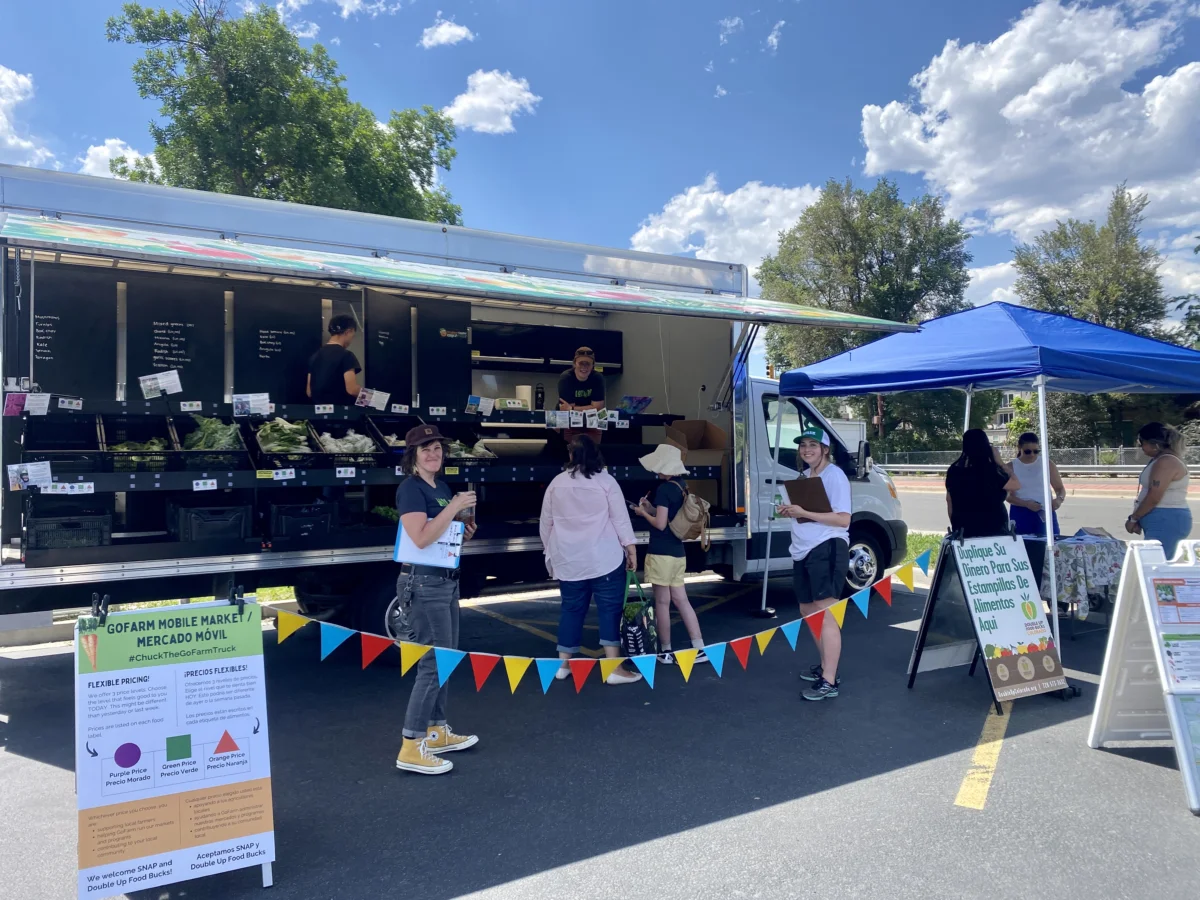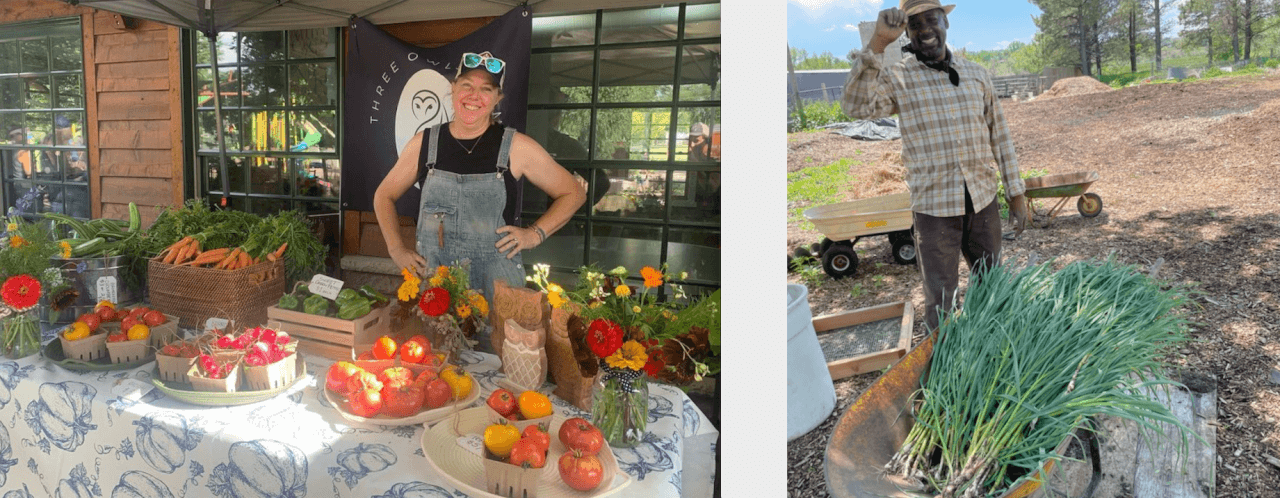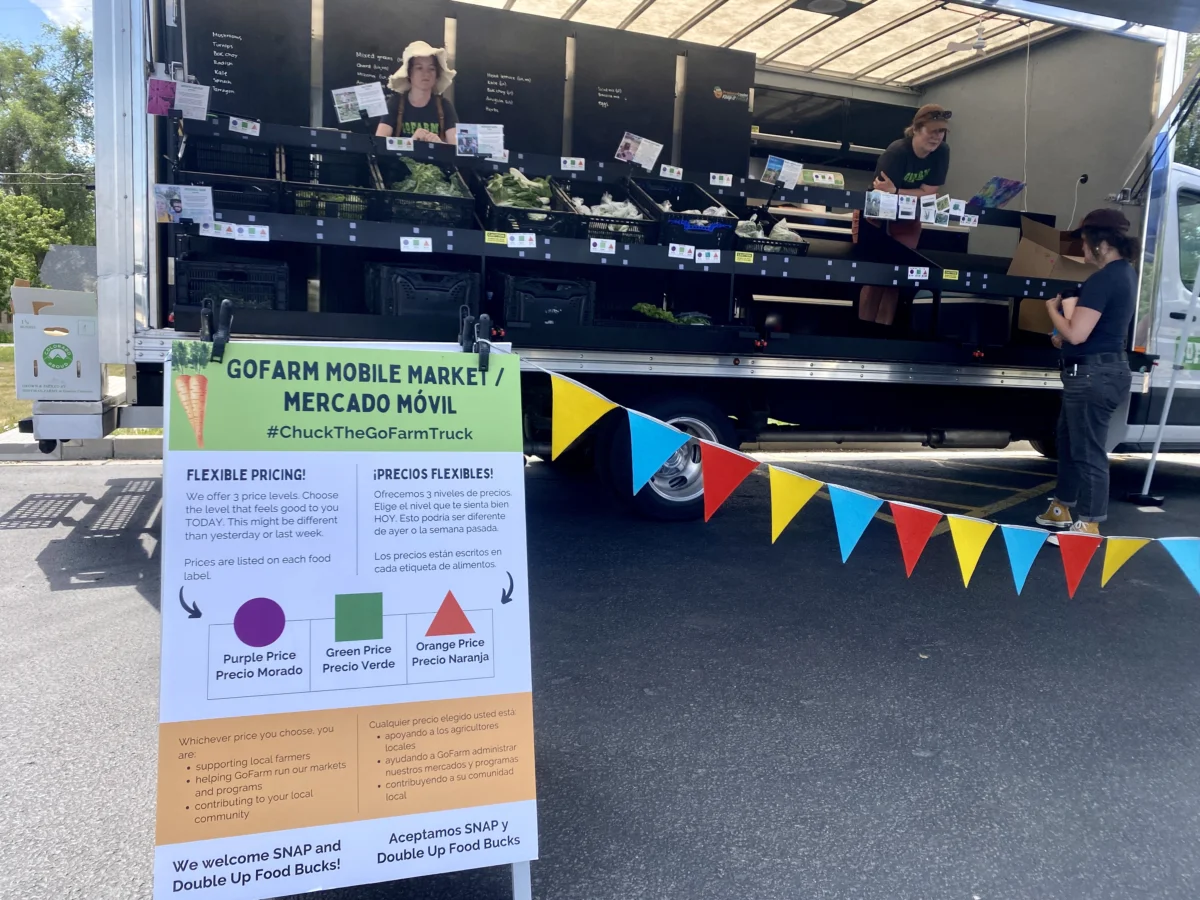Meet the Nonprofit Training Farmers and Feeding a Whole Community
GoFarm is tackling two sides of the food system: focusing on farmer development and community access to affordable healthy food.
Meet the Nonprofit Training Farmers and Feeding a Whole Community
GoFarm is tackling two sides of the food system: focusing on farmer development and community access to affordable healthy food.

Chuck, the mobile market truck, in action. by Lindsey Beatrice
Throughout the summer in the Golden, CO area, you might see a big box truck full of local fresh vegetables hosting a pay-what-you can farmer’s market. Affectionately called Chuck, GoFarm’s mobile market truck travels to low-income neighborhoods, schools, retirement homes, mobile home communities and more. It offers local produce that GoFarm sources from 80 to 90 farms every season, including small-scale urban farms, large family-owned farms and beginning farmers going through their incubator program.

“Our vision is a strong, resilient, environmentally sustainable and equitable local food system,” says Virginia Ortiz, GoFarms executive director.
Ortiz sees GoFarm’s role as a hub that takes care of the logistics of supporting small farms and feeding the community.
Building community partnerships is a crucial element, and GoFarm works with other food access organizations such as Hunger Free Golden and JeffCo Food Policy Council to reach more people and create a broader base of resources.
Founded in 2014, GoFarm started with its local food share program (essentially a CSA curated from multiple farms). More than a decade later, it has become an organization that trains and develops beginning farmers and creatively tackles the problem of how to get affordable, fresh food to the community. As a nonprofit, it is able to fundraise for grants and donations to support its programming and supplement that with revenue generated through produce sales.
GoFarm’s incubator farmer program gives beginning farmers access to a quarter acre of land for the two-year duration of the program. The farmers receive all the training they need to plan, plant and manage a farm—regardless of their background.
“The average age of current farmers is 55 to 59, and we know that, over the next 10 years, half of current farmers are going to retire, which means that we need to develop a new base,” says Ortiz. But she points out that there is a “tremendous need” for agricultural education.

“Part of our goal is to change the paradigm of farm ownership. Currently, in Colorado, there are approximately 34,000 farms and only one percent are owned by people of color. Yet, 95 to 98 percent of farm workers are people of color, primarily Latinos,” says Ortiz, who shares that she comes from a long line of farmers and farm workers. She says she is proud that, in the farmer development program, 50 percent of participants are people of color, 65 percent are women and 40 percent self-identify as LGBTQ+.
Moses Smith of Full Fillment Farms was an engineer who had gardened before taking GoFarm’s 20-week course and joining the incubator program. “The important thing was the Whole Farm Planning course that really focused on what it takes to actually grow food,” says Smith.
“One of the biggest benefits is that they not only provide us with land access, which is very hard as a starting farmer, but they also give us a market avenue,” says Ann Poteet of Three Owls Farm. As incubator farmers are establishing their businesses and learning how to generate their own markets, they sell produce back to GoFarm.

GoFarm’s local food share program feeds anywhere from 500 to 800 members each summer. Members come every week to pick up their share from a few different locations where GoFarm has refrigerated shipping containers to store food after it’s delivered by farmers. Plus, GoFarm takes Chuck out and about in Denver and Jefferson counties every week to ensure they can reach underserved populations that are challenged with food insecurity, disability, transportation and other barriers, such as the communities living in designated food deserts in south Golden.
“I have an interest in nutritional insecurity,” says Poteet, who was a nurse practitioner before starting her farm.
“It’s been really inspiring,” says Smith about being able to see his food nourish the community through GoFarm.
But farmer’s market prices can be high, as producers need to be fairly compensated for their labor and costs. “Customers were clear to us that having access to healthy food was critical to them and affordability was a barrier,” says Ortiz. So, in 2022, GoFarm found the funding it needed to implement a new solution that goes even further to improve accessibility for the 2,600+ households it reaches.
Customers at its mobile markets can choose from one of three price tiers to shop that day, depending on their needs. For example, bags of mixed greens have three prices listed: $2 (purple), $3 (green) and $4 (orange). And the microgreens are even cheaper, at $1, $2 or $3 for a box. Pasture-raised eggs can be $3, $5 or $7 a carton.

“You are what you eat,” says Kaylee Clinton, a first-time GoFarm mobile market shopper. “I just feel better about myself when I eat fresher.” As inflation has hit grocery stores, she says that SNAP has helped make food more affordable and she appreciates that GoFarm lets shoppers pick their price point. “I really love it. I think it’s great for everybody.”
“Typically, I either buy green or orange. I like buying orange when I can. It’s good to have the flexible pricing,” says Ed Gazvoda, who has been shopping at GoFarm for years. “I want to live a good, long, healthy life, so it’s a personal thing, but I just love the food.”
Jess Soulis, director of the Community Food Access program, highlights that accepting SNAP’s DoubleUp Food Bucks—where shoppers essentially get a 50-percent discount—is just one way to make food more affordable. The group also partners with WIC’s Farmers Market Nutrition Program, where participants get a credit to shop. Through its market locations at Littleton Advent Hospital and Juanita Nolasco Senior Residences, the program offers shoppers $10 worth of produce for free. SNAP/DUFB account for 13 percent of its mobile market sales, but all of these incentives combined are closer to two-thirds.
“We’re building this beautiful, vibrant, local food system and we don’t want to replicate the injustices and inequities that are so prevalent in the existing food system,” says Soulis.
The vision continues to grow. The only limitation? “Infrastructure,” says Ortiz. GoFarm is currently seeking out refrigerated warehouse space along the I-70 corridor between Golden and Montbello.
“That area is important because we need to make it accessible to farmers along the Front Range,” says Ortiz. “With that refrigerated warehouse space, we could easily source from more farmers, distribute more food and serve more communities.”
Follow us
This work is licensed under a Creative Commons Attribution-NoDerivatives 4.0 International License.
Want to republish a Modern Farmer story?
We are happy for Modern Farmer stories to be shared, and encourage you to republish our articles for your audience. When doing so, we ask that you follow these guidelines:
Please credit us and our writers
For the author byline, please use “Author Name, Modern Farmer.” At the top of our stories, if on the web, please include this text and link: “This story was originally published by Modern Farmer.”
Please make sure to include a link back to either our home page or the article URL.
At the bottom of the story, please include the following text:
“Modern Farmer is a nonprofit initiative dedicated to raising awareness and catalyzing action at the intersection of food, agriculture, and society. Read more at <link>Modern Farmer</link>.”
Use our widget
We’d like to be able to track our stories, so we ask that if you republish our content, you do so using our widget (located on the left hand side of the article). The HTML code has a built-in tracker that tells us the data and domain where the story was published, as well as view counts.
Check the image requirements
It’s your responsibility to confirm you're licensed to republish images in our articles. Some images, such as those from commercial providers, don't allow their images to be republished without permission or payment. Copyright terms are generally listed in the image caption and attribution. You are welcome to omit our images or substitute with your own. Charts and interactive graphics follow the same rules.
Don’t change too much. Or, ask us first.
Articles must be republished in their entirety. It’s okay to change references to time (“today” to “yesterday”) or location (“Iowa City, IA” to “here”). But please keep everything else the same.
If you feel strongly that a more material edit needs to be made, get in touch with us at [email protected]. We’re happy to discuss it with the original author, but we must have prior approval for changes before publication.
Special cases
Extracts. You may run the first few lines or paragraphs of the article and then say: “Read the full article at Modern Farmer” with a link back to the original article.
Quotes. You may quote authors provided you include a link back to the article URL.
Translations. These require writer approval. To inquire about translation of a Modern Farmer article, contact us at [email protected]
Signed consent / copyright release forms. These are not required, provided you are following these guidelines.
Print. Articles can be republished in print under these same rules, with the exception that you do not need to include the links.
Tag us
When sharing the story on social media, please tag us using the following: - Twitter (@ModFarm) - Facebook (@ModernFarmerMedia) - Instagram (@modfarm)
Use our content respectfully
Modern Farmer is a nonprofit and as such we share our content for free and in good faith in order to reach new audiences. Respectfully,
No selling ads against our stories. It’s okay to put our stories on pages with ads.
Don’t republish our material wholesale, or automatically; you need to select stories to be republished individually.
You have no rights to sell, license, syndicate, or otherwise represent yourself as the authorized owner of our material to any third parties. This means that you cannot actively publish or submit our work for syndication to third party platforms or apps like Apple News or Google News. We understand that publishers cannot fully control when certain third parties automatically summarize or crawl content from publishers’ own sites.
Keep in touch
We want to hear from you if you love Modern Farmer content, have a collaboration idea, or anything else to share. As a nonprofit outlet, we work in service of our community and are always open to comments, feedback, and ideas. Contact us at [email protected].by Lindsey Beatrice, Modern Farmer
July 2, 2024
Modern Farmer Weekly
Solutions Hub
Innovations, ideas and inspiration. Actionable solutions for a resilient food system.
ExploreExplore other topics
Share With Us
We want to hear from Modern Farmer readers who have thoughtful commentary, actionable solutions, or helpful ideas to share.
SubmitNecessary cookies are absolutely essential for the website to function properly. This category only includes cookies that ensures basic functionalities and security features of the website. These cookies do not store any personal information.
Any cookies that may not be particularly necessary for the website to function and are used specifically to collect user personal data via analytics, ads, other embedded contents are termed as non-necessary cookies.